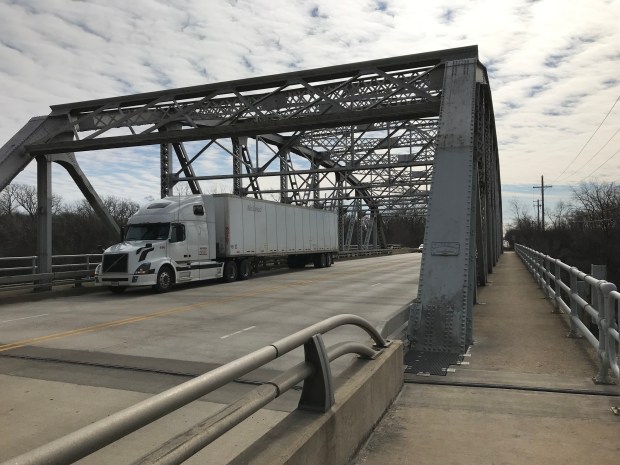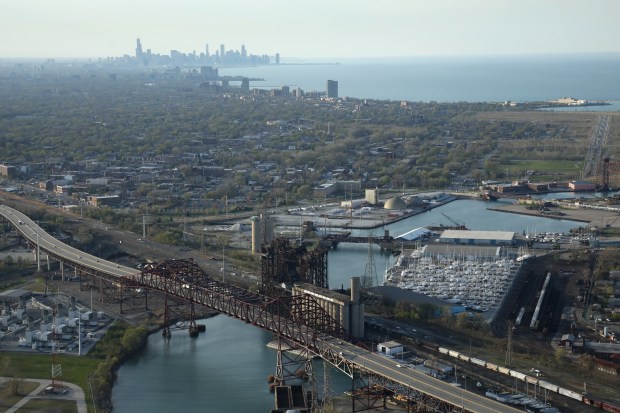Chicago’s bridges are internationally famous and celebrated locally, except perhaps by those waiting in traffic when a drawbridge is raised.
“They’re part of the fabric of our city,” said Margaret Frisbee, executive director of Friends of the Chicago River, which operates the McCormick Bridgehouse & Chicago River Museum downtown. “Chicago is here because the river is here, and the bridges tell the story of our history and how it evolved.”
That includes the engineered waterways that created links between the Great Lakes and the Mississippi River system, such as the Cal-Sag Channel. The area’s canals and associated infrastructure “continue the narrative of Chicago using the river system to keep itself on the map, creating this network of waterways for commerce.”
That network, along with the overlay of rails and roads locking into the city’s grid system, created an environment where more bridge patents were filed than anywhere else in the country, Frisbee said. Chicago has more drawbridges than any city in the world aside from Amsterdam, according to Patrick McBriarty, historian and writer of the authoritative guide,”Chicago River Bridges.”
The serene lakefront and playful Riverwalk belie downtown Chicago’s port city heritage, where in the 1880s ship arrivals and departures outpaced all the ports on the East and West coasts, McBriarty said.
“Bridges were opening or swinging as often as four or five times an hour,” he said. People at street-level were increasingly late. Though Chicago became “a crucible for new bridge design,” McBriarty said, the city’s famous movable spans likely weren’t much appreciated.
When the Cal-Sag Channel opened a few decades later, drawbridges were mostly left out of the plans, with the notable exception of the 95th Street Bridge over the Calumet River that was famously jumped in “The Blues Brothers” movie.
For one thing, advances in tug boats equipped with hydraulic lifts enabled wheelhouses that could be lowered so they could fit under fixed bridges.
Still, the designers of the Crawford Avenue bridge over the Cal-Sag weren’t sure. One of the oldest bridges along the channel, the Crawford bridge was designed to accommodate lift towers should future shipping traffic require additional clearance, according to its listing on historicbridges.org.
That never happened, and in the nearly 100 years since it was constructed in 1932, the bridge has quietly done its job connecting Robbins and Alsip via Pulaski Road.
A small metal plaque bolted to the steel girders of the bridge is easy to miss. It’s the same color as the rest of the structure that carries thousands of daily motorists along its four-lane span. It states the bridge was erected by McClintic-Marshall, an engineering firm involved with historic bridges throughout the country, including building the towers and floor structure of the George Washington Bridge in New York City.
By the time it built the Crawford Avenue Bridge, the company had been purchased by Bethlehem Steel, though it still retained its own corporate identity. That changed in the wake of its involvement with another, even more famous bridge later that decade. Scoring the contract for construction of the Golden Gate Bridge in San Francisco would spell the company’s doom.
According to Bethlehem Steel Corporation records housed and posted online by Hagley Museum and Library in Delaware, “When Bethlehem Steel Chairman Eugene Grace saw McClintic-Marshall’s name on the Golden Gate Bridge instead of Bethlehem’s, he quickly ordered the McClintic-Marshall Corporation merged into the Bethlehem Steel Company.”
Though Bethlehem’s logo appears on the plaque affixed to the bridge over the Cal-Sag, it’s dwarfed by the McClintic-Marshall name. Evidently, Eugene Grace didn’t care much about Bethlehem’s bragging rights in Robbins.

The bridge continues to be called the Crawford Avenue bridge, even though the name of the street was officially changed, at least in Chicago, to Pulaski Road just two years after it was erected. Crawford was named by Peter Crawford, an early politician who helped organize Cicero Township, which lent its name to Cicero Avenue, the next main drag to the west.
Even now, the Crawford/Pulaski debate is casually rekindled from time to time, but Cook County officials have settled on the newer name as they mull a major project along the roadway that encompasses the bridge span.
The Pulaski Road Corridor Study, a long-range process that kicked off in 2020 and is anticipated to be completed in 2025, encompasses a stretch of Pulaski from 159th to 127th streets in Markham, Midlothian, Robbins, Crestwood and Alsip.
Jennifer “Sis” Killen, superintendent of the Cook County Department of Transportation, said it’s a way to “address existing deficiencies in the roadway while adding pedestrian amenities.”
“We’re reimagining what this corridor will look like,” she said.
Part of the process is figuring out what to do about the Crawford Bridge, which the Illinois Department of Transportation rated as structurally deficient in 2019. The bridge was repaired in 2022, but replacement was listed among the potential outcomes of the Pulaski Corridor study.
Preliminary investigation indicates the bridge is historically significant and eligible for listing on the National Register of Historic Places.
Historicbridges.org gives the Crawford span a six rating on a scale of 10 from a national standpoint, while upping its rating to seven from a local perspective as “one of the oldest truss bridges on these waterways.”
“The bridge stands out among the group as significant … a traditionally composed example of a 1930s through truss bridge,” it’s listing states.
Killen said the county has taken note of its historic significance.
“How can the structure be preserved and what alternatives do we have so it’s not a reconstruction of that structure, because of its historical presence and identity?” she said.
“Our first goal is to not have any impact at all. If impact is required, we need to minimize that impact to the highest degree we can.”
Killen said the bridge now is in “good shape” thanks to the 2022 work, which gave planners “time and space to evaluate and prioritize improvements for the corridor and the bridge itself.”
“We don’t want to disrupt historic elements that are important to communities,” she said.
Most of the other bridges over the Cal-Sag were constructed in the 1960s and ‘70s, making the Crawford bridge a poster child for the area’s historic bridges, one with solid links to its very famous cousins on both American coasts.
It may not be as celebrated as Chicago’s drawbridges, but it has its own significance in the region’s story.
“One of the cool things about Chicago is the amazing and historic bridges,” said Frisbee, from the McCormick Bridgehouse Museum. “They’re all individual — they’re all really fabulous.”
Landmarks is a column by Paul Eisenberg exploring the people, places and things that have left an indelible mark on the Southland. He can be reached at peisenberg@tribpub.com.




